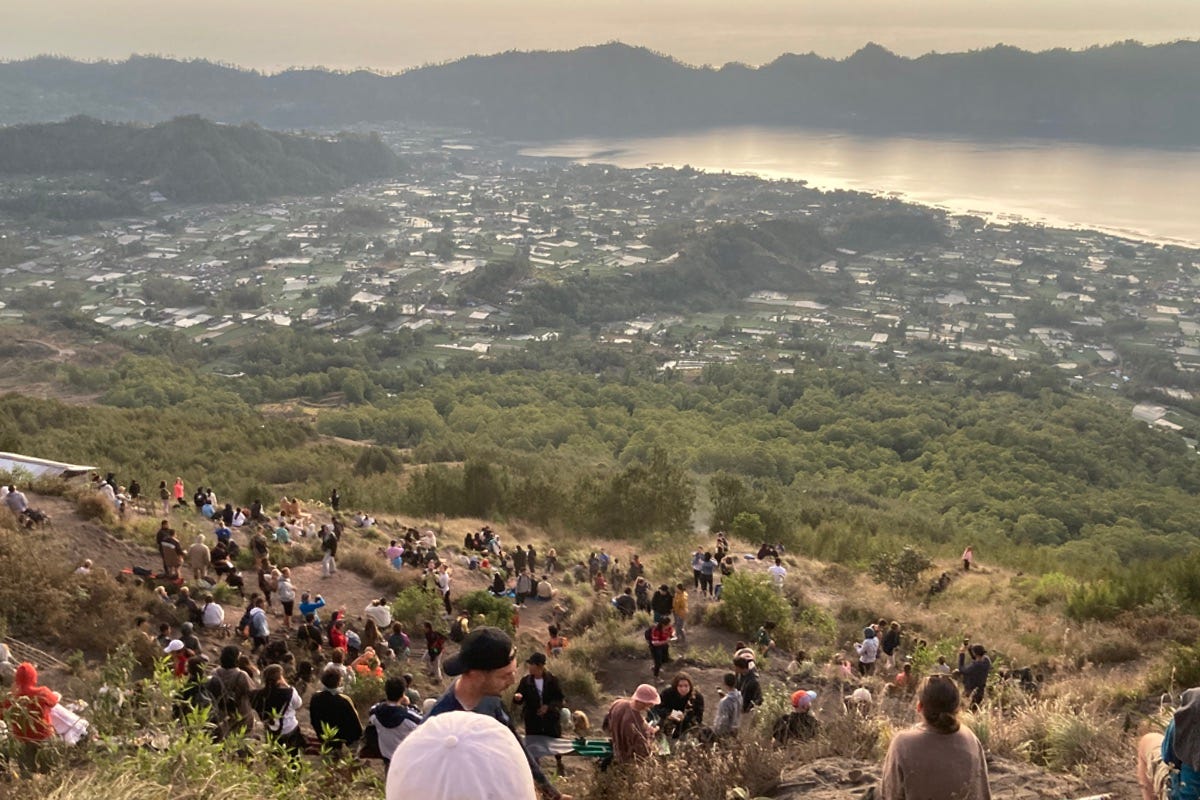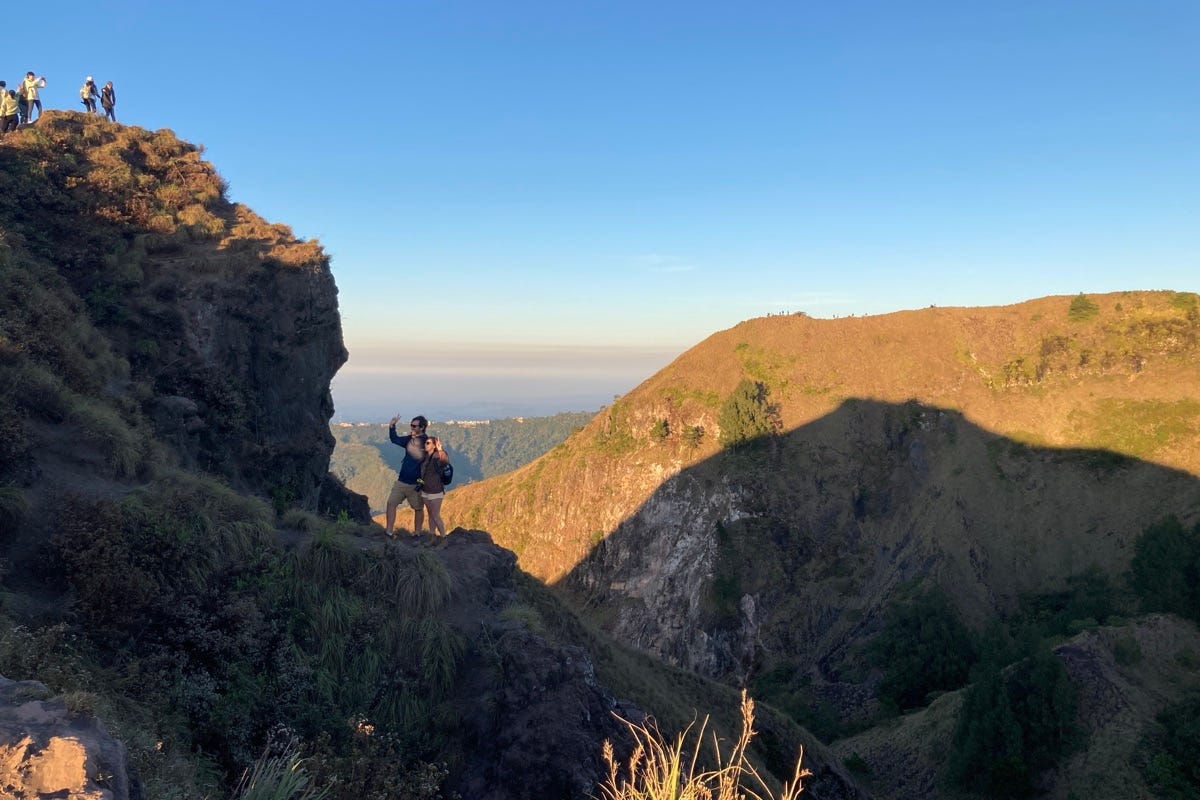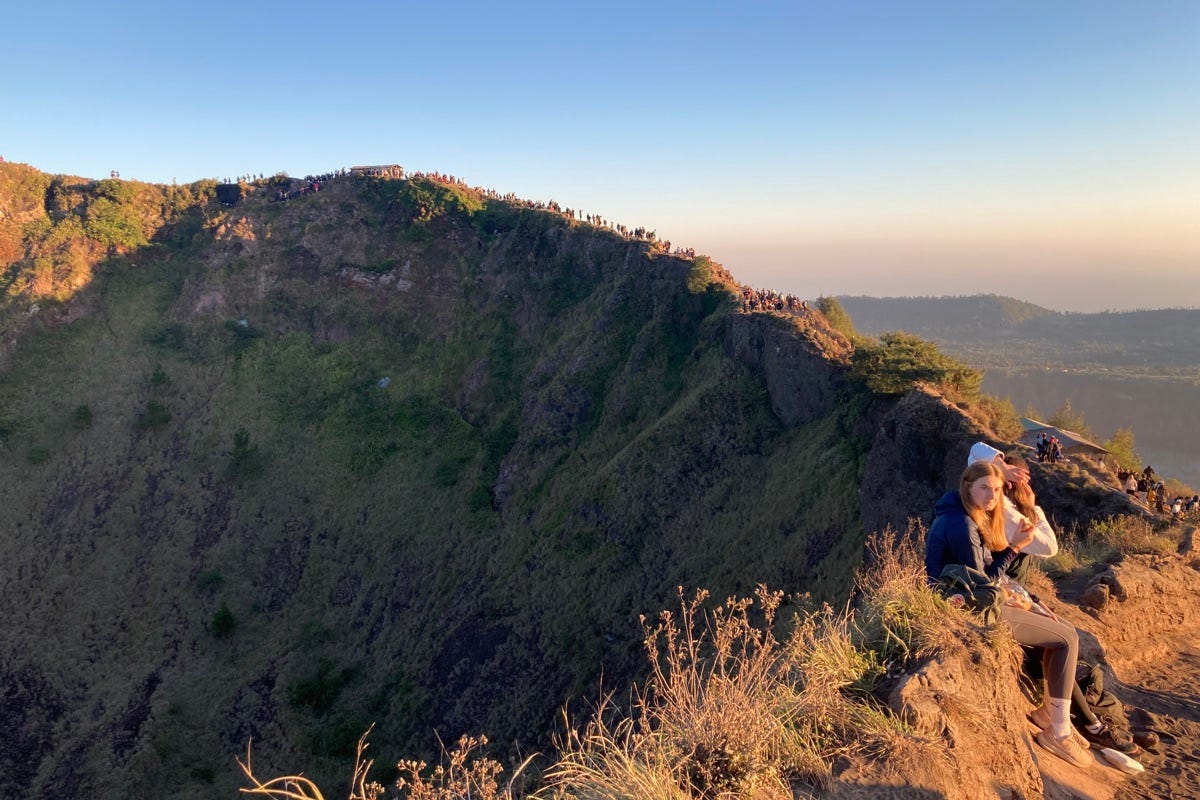A quick word of introduction. My name is Stuart McDonald and this is Couchfish—the perfect tub of ice-cream for the traveller stranded on the couch. The newsletter has both a paid edition which traces a fantasy itinerary through Southeast Asia, and a free one that covers, well, everything else.
This is the conclusion of a two-part series and you can read part one here. Yesterday I looked at the stories behind Bali’s Mount Batur and what the trekking experience can be like today. Today, some thoughts on how perhaps the visitor experience could be better managed. Both pieces are free-to-read, but if you’d like to support me finding more tourism stuff to moan about, please consider becoming a paid subscriber. Thank you.
Earlier this year, news did the rounds that Bali was to close its volcanoes. There would be exceptions for religious and other cultural needs, but trekking—by both local and foreign tourists—would end. The reason? The actions of a minuscule minority of—mostly foreign—tourists striding up the peaks and into full-blown idiocy. No, I’m not linking to any of the stories about those clowns, sorry.
Balinese see both Agung and Batur as holy peaks, but you didn’t need to be Balinese to be aghast at some of the ridiculous behaviour. The tourism industry, in particular trekking guides, did not support the measure, and, as with other proclamations of a similar tilt, nothing came of it.
There’s always a goddam drone. One of at least six I saw—the crater is full of dead ones apparently. Photo: Stuart McDonald.
While at the summit last weekend, I didn’t see any naked Russian influencers or Canadian healers. In fact I didn’t see anyone nekkid—it’s cold, and I’d have been content with more clothes rather than less. What I did see was way too many people. Not only too many people from an aesthetic or experiential point of view, but also from one of safety. Trekkers continue to die and maim themselves on Batur and other peaks in the country, yet safety briefings, signage, fencing, and so on, as far as I saw, were non-existent. Despite these safety issues, the volume of people—and their impact—seemed to be less of an issue when it came to proclamations about closing the peaks.
Despite the accidents—many minor ones of which, according to our guide, go unreported—Batur is an easy climb. Depending on how long you linger at the summit beach party, you’re looking at three to four hours up and back. Agung is a good bit more challenging, and takes seven to nine hours, sometimes longer. When we climbed Batur, there were plenty who’d never set foot on a volcano before. I talked to Australians, Bangladeshis, Brits, Indians, Indonesians, Saudis, and South Koreans, among others. In all but the Indonesian case, they’d never climbed a volcano before. If someone comes to Bali and wants to climb one, in the past having never climbed anything but their laundry stairs, Batur works. The thoughts of those I spoke to I can sum up in two words: Beautiful and busy.
So how to address the latter and preserve the former, while not hitting the hip pocket of local residents? Also, how best to rope in the tourist idiocy that saw chit chat of a climbing ban in the first place? A typical approach is to jack up prices. This pushes it out of the reach of budget travellers who are—without any proof—often portrayed as being the source of most of the idiocy.
Today I’m arguing the opposite—to drop prices ... sort of.
No more cruise trekkers
Day tourists, those who don’t stay overnight in Kintamani, are the least valuable, highest impact kind. Sure they pay for the trekking, but that’s it. They don’t pay for a hotel nor homestay, nor the meals a stay entails. They drive in and drive out on the same day, contributing to Bali’s ghastly traffic. My solution? If you don’t stay in the immediate Kintamani area for two nights, you can’t climb Batur.
Still filling up. How many were day trippers? Photo: Stuart McDonald.
Why am I arguing for two nights rather than one? Because Kintamani and its surrounds have enough to kill two days. Indeed you can base yourself there and visit a range of further flung spots, that people tend to do from Ubud. This would be a win for Kintamani businesses as you’d be spending more money, and across a more diverse range of businesses.
Without a doubt, mandating a two night stay would reduce the number of people climbing. In turn, trekking revenue would fall. However, in staying two nights, the overall spend in the area would increase. Research has shown that some residents feel tourism isn’t delivering the financial windfall some hoped for, so this could help.
This feeling of tourism “not delivering” is in part because the activities are so concentrated on the peak. There’s volcano jeep riding and black-sand motor-cross riding for example—but spend some time looking at the tours on offer. Most include hotel pickup and drop off—from anywhere in Bali. The subtext? Many of these guests are not overnighting in Kintamani. Not only that, they’re often buying a tour through an overseas company—further reducing their local spend as the overseas agency takes a cut.
Reform the trekking business
As with Mount Agung, almost all trekking on Batur is at sunrise. Aside from the beauty, there are weather considerations at play as the peaks often cloud over in the afternoon. That said, it is often clouded in at sunrise too—the day before we climbed it was cloudy, when we did, it was crystal clear. Make an offering to the weather gods the day before.
Immediately behind these two it is a sheer drop. According to our guide someone fell to their death from here a few years ago. Photo: Stuart McDonald.
I also suggest a hard cap on the number of tickets available daily. Tourists plan their flights and hotels in advance and there is no reason why they can’t do the same with a volcano climb. Offer the tickets online only, through a centralised online portal to keep one hundred per cent of the funds in-country. No ticket, no climb. As it stands, despite being a UNESCO Global Geopark, Batur doesn’t appear to have a functional website. Likewise, their Facebook page is infrequently updated. You can see an archived version of the former here. This is to say, I’m not suggesting this could be set up with a click of the fingers, but, come on fellas.
I’d also suggest that slots be available for three times—sunrise, daytime, and sunset. If sunrise is the most in demand, then price it higher. As a point of reference, currently two trekkers will pay anything from 400,000 to 750,000 rupiah all up a head—we paid 500,000 rupiah. Something like the following (note these are only for access and do not include transport, add-ons etcetera) could be a starting point:
Dawn (start 04:00): 300 tickets 250,000 rupiah
Daytime (start 08:00-14:00): 200 tickets 100,000 rupiah
Sunset (start 16:00) 200 tickets 175,000 rupiah
As it stands, a chunk of what you pay goes to The Association of Mount Batur Trekking Guides—the above should replace that. This community organisation is not without controversy, but I’m not getting into that here. If you’re curious, pages 9-11 of this paper are a good starting point. My point is, if you want to climb Batur, you pick an agency to use, but you buy your Batur Pass independently, online. No pass, no climb. The agency can still make their money through guide fees, transport, add-ons etcetera as they already do. They just lose the ability to sell—and mark up—the access fee. As is the case now, this access pass money could continue to go towards wages, social endeavours and keeping the trails clean. By Indonesian standards, Batur’s trails have a limited trash problem—well done.
According to our guide, where I am standing in taking this photo, some years ago a British woman stepped straight off the rim into the crater before dawn. She didn’t have a torch and wanted to change her trousers, but didn’t realise where she was. She broke her neck and some limbs, but survived. Photo: Stuart McDonald.
With something like this, further people management tools become available. Think seasonal variations—50 per cent more in peak season July and August, 25 per cent less over monsoonal November through to February. Having the majority of tickets booked in advance brings with it plenty of business planning benefits. Most importantly, the ticket numbers should be hard capped. Get some volcano carrying capacity person—ie., not me—to take a look and figure it out. I am pretty confident though in suggesting a thousand people at the summit is not ideal.
There’s no doubt the trekking scene is bringing money and jobs into Kintamani. But for whom? At a glance, most guides are young men, which is typical in Indonesia. On our climb, I don’t think I saw a single female guide, though guides are not indicated by a badge or anything, so I can’t be sure. I did see plenty of women selling snacks, drinks, and polished lava bracelets at the summit. Female trekking guides have been a selling point on Lombok’s Rinjani, so why not on Batur? According to one Batur trekking company, of 600 trekking guides, ten are women. Smart operators should get onto this.
Say no to idiocy
As already mentioned, Balinese view both Agung and Batur as holy peaks. It should come as no surprise to most that people getting nekkid, having sex, or filming themselves having sex, are not in tune with local sensibilities. A step or three down the idiocy list, flying a drone likewise, is not permitted. This last one is a bit complicated, as the government site seems to suggest you need a license, but it’s not very accessible for non-Indonesian speakers, which would include most foreign tourists. Drone sites meanwhile, suggest otherwise. This confusion aside, in Bali, drone pilots do need permission to fly a drone over a religious site. On this count, both Agung and Batur qualify.
On the way down the crowds are gone and we’re able to have a safer separation between people. Photo: Stuart McDonald.
The best way to address these points is by requiring visitors to read and sign a plain language document outlining rules and norms. At least then, when someone gets their gear off to nude-pilot their drone while they’re having sex, they can’t say they didn’t know. And they sure can’t whine when they’re punished. Obviously this document should be a part of the online booking process.
But this isn’t fair!
I imagine some are reading this and thinking, well this isn’t fair. That they’d like to climb Batur but can’t afford to give Kintamani two nights. My answer to that is to either take a longer trip, or to rejig your existing itinerary so that you can fit it in. Prioritise your trip accordingly—you can’t do everything.
Slow down and smell the coffee—I hear Kintamani isn’t bad on that front.
Couchfish is 100 per cent independent and reader-supported. If you’re not already a subscriber, and you’d like to show your support, become a paying subscriber today for just US$7 per month—you can find out more about Couchfish here—or simply share this story with a friend.
Don’t forget, you can find the free podcasts on Apple, Pocket Casts and Spotify as well as right here on Couchfish.














